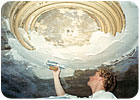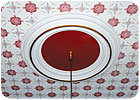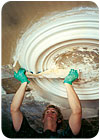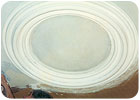
Applying plaster to a badly deteriorated medallion.
Like so many of the skilled tradesmen who read Walls & Ceilings, my family has a deep tradition in the plastering industry. And like so many of the readers, I learned much of what I know from my father and I will be forever grateful for the knowledge he has so unselfishly passed on to me. Whether intentional or unintentional, I also caught the passion for plastering. Realizing the rich history of ornamental and restoration of plaster has made plastering less like work and more like a hobby. This allows me to combine being a skilled mechanic and an artist into one profession. How many other trades or even professions can claim that?
Working with my father on the art of ornamental plaster as well as the restoration of many historic projects has deepened my sense of tradition and respect for the trade, history and romance of plaster and the father-son relationship. As my passion for plastering grew, so did my thirst for knowledge about the long history of plaster and plastering.

This formerly deteriorated ceiling medallion was restored to its former glory by the author at the historical Cappon House in Grand Rapids, Mich.
HISTORY AND ROMANCE OF PLASTER
In researching the history of plaster, one invariably comes across the writings of Marcus Vitruvius Pollio, the chief engineer of the Roman world under Julius Caesar. He was well known for his architecture and his writings on the subject of architecture and construction. He wrote a collection of books called the “10 Books on Architecture.” He also took a keen interest in plaster and plastering materials. He meticulously recorded what materials were used and the methods for installing the plaster. His books were a record of what proved to be the successful plasters and which materials and/or procedures did not deliver as expected.Experience taught him that the best materials for interior plastering were limestone and the use of volcanic ash as the gauging. People were often limited to use only what materials were available to them and volcanic ash was not readily available to most architects or plasterers. Marcus Vitruvius was kind of fortunate; he had an abundance of volcanic ash at his disposal from the nearby Mt. Vesuvius.
Like any good architect, Vitruvius sought out plaster materials that were beautiful and would be durable. The Green Building Council and those involved in promoting sustainable construction would have been proud of Vitruvius.
Today there is a rebirth in sustainable construction combining beauty and durability using basic building materials. While interior plaster systems generally have an initial up-charge for the installation, the benefits of beauty and longer life expectancy make architects take a second look at real plaster. Ornamental plaster is making a renaissance of its own. There has been recent interest in more elaborate and ornate designs more reminiscent of the past. Plasterers with the craftsman skills to complete these projects will find new avenues to pursue their passion.
Vitruvius and his books have passed on some unique material blends and application techniques for specialty plaster finishes. These materials and techniques took traditional plaster of the day and added life to the finish. For me, I found the research awoke another passion in me-the experimenter and the inventor.
I began to blend the knowledge my father had passed along with the Vitruvius lessons and expanded it to modern materials, and as a result have created new finishes that once again brought new and broader possibilities in design with decorative and restoration of plasters. I have learned that there is a market for unique specialty plaster finishes such as Olive Stone, True Venetian and Scagliola. There is a growing interest among designers and architects in the romance and history of plaster.

Running the template.
BRINGING IT BACK
I have been fortunate to work on some projects with ornamental plaster in need of restoration and the end result was simply amazing. For example, on a historic home in Michigan we were asked to restore some damaged crown moldings and ceiling medallions. We were able to take a ceiling medallion where only half of the original medallion remained and restore it to its original beauty. The template is the key to preserving an original piece of ornamental plasterwork. If any part of the original still remains, you can construct a template matching the existing lines of the ornamentation. If no part of the original is left to copy, then you would design a template that will fit the style and size of the area and be aesthetically pleasing.Running templates for mold plastering is time-consuming and tedious. The plaster is added in layers (passes) and the template is run after each layer of plaster is added until the medallion or other plaster ornamentation is complete. In some cases, including the medallion pictured, it took 100 passes of adding thin layers of plaster and running the template to achieve the look we desired. This ceiling shows why I love this aspect of ornamental work so much; the end result is beautiful.

The completed product.
Historic preservation is true plastering at its highest art form. The respect preservation plasterers garner from others in the design and construction community will be reminiscent of the clout our forefathers in plastering enjoyed. It is worthwhile for those who become experts to pass their skills on to others. The more ornamental and restorative plastering spreads, the more business there will be for all of us in plastering. The list of the types of buildings nationwide that are in need of historic preservation is very long; libraries, hotels, apartments, housing, City Hall, universities, etc.



